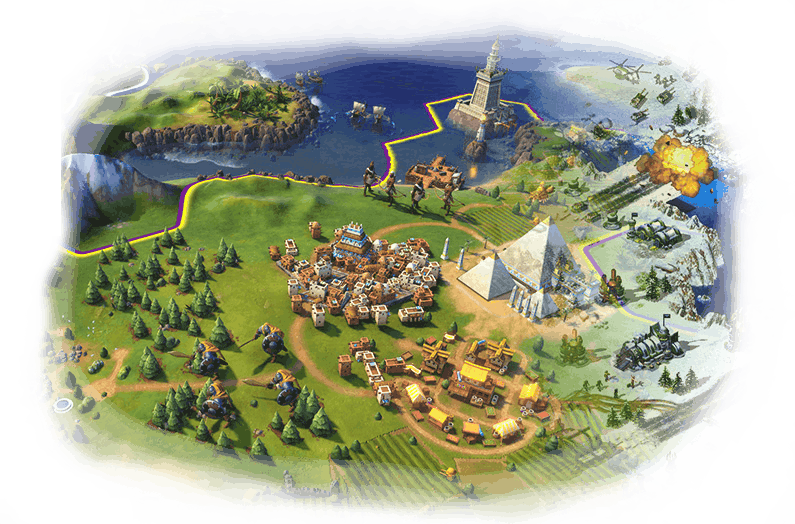Top 3 Blockchain strategy Games
- Blockchain strategy games are built on blockchain technology and now give you a chance to earn real crrypto rewards, adding another layer of complexity to traditional strategy games.
- Blockchain technology introduced the concepts of true digital scarcity and complete transparancy, players can now own their digital assets.
- The assets are unique on the blockchain, which makes them valuable and tradable.



Prospectors
Prospectors.io is an economic multiplayer strategy EOS game with real financial and trading aspects. It’s set-up in the gold rush of the nineteenth century.
- Earn crypto playing a real time economic strategy game
- play for free and slowly work your way up
- Buy a plot and take a role of a business owner, with real crypto rewards
Read Review

CryptoWars
CryptoWars is a multiplayer strategy crypto game that runs on the Loom blockchain. Build your village, raise an army, and attack your enemies to earn crypto.
- participate in tournament, enter for free and get a chance to earn crypto rewards.
- Everything you obtain in the game is yours on the blockchain.
- Active development
Read Review

Blocklords
Blocklords is a strategy crypto game with RPG elements. The game takes place in medieval Europe, where players can battle each other and NPC to gain experience and crypto rewards.
- Conquer cities that generate real crypto rewards.
- capture strongholds for a chance to receive valuable crypto assets
- The game won the Tron accelerator award and NEO blockchain award.
Read Review
Blockchain Strategy Games
A strategy video game is a game that focuses on skillful thinking and planning to win. It highlights strategic, tactical, and sometimes logistical challenges. Many games also offer challenges and economic explorations. They are generally divided into four subtypes, depending on whether the game is turn-based or real-time. And whether the game is strategy-oriented or tactical.
Definition
Strategy games are a genre of video games that emphasize intelligent thinking and planning for victory. In particular, a player must plan a number of actions against either one or multiple opponents, while the reduction of enemy forces is usually a goal. Victory is achieved through superior planning, and the element of chance usually plays a less important role. In most strategy video games, the player gets a view worthy of the game world and indirectly controls the units of play under his control. As a result, most strategy games involve elements of war to varying degrees and combine tactical and strategic considerations. In addition to combat, these games often test the player’s ability to explore or manage an economy.
Strategy games and other genres
Although many action games involve strategic thinking, they are rarely considered strategy games. A strategy game is usually more extensive and focuses on the player’s ability to rethink his opponents. Compared to other genres, such as adventure and action games, where one player competes against many opponents, strategy games usually have some symmetry between the pages. Each page generally has access to similar resources and actions, with each page’s strengths and weaknesses generally balanced.
Although strategy games involve strategic, tactical, and sometimes logistical challenges, they are different from puzzles. A strategy game requires the planning of a conflict between players, while puzzles require isolated planning. Strategy games also differ from design and management simulations that involve non-combat economic challenges. These games may involve a certain amount of conflict but are different from strategy games as they do not emphasize the need for direct action on an opponent.
Although strategy games are similar to role play in that the player has to manage units with a variety of numerical attributes. RPGs are usually a smaller number of unique characters, while strategy games focus on a larger number of fairly similar units.
Game design
Units and conflict types
The player controls his forces by selecting a unit, usually by clicking on it with the mouse and issuing a command from a menu. Keyboard shortcuts become important for advanced players because speed is often an important factor. Units can normally move, attack, pause, and hold a position, although other strategy games offer more complex commands. Units may even have special abilities, such as the ability to become invisible to other units that are generally balanced with abilities that otherwise recognize unseen things. Some strategy games even offer special leader units that grant bonuses to other units. Units may also be able to navigate or fly over otherwise impassable terrain or carry other units. Off-combat abilities often include the ability to repair or build other units or buildings.
Even in imaginary or fantastic conflicts, strategy games attempt to reproduce serious tactical situations in the story. Techniques such as flanking, re-routing, or cutting supply lines can be an integral part of combat management. The terrain becomes an important part of the strategy as units can gain or lose landscape benefits. Some strategy games, such as Civilization III and Medieval 2: Total War, involving other types of conflict, such as diplomacy and espionage. However, war is the most common form of conflict, as game developers have struggled to view non-violent forms of conflict as attractive.
Economy, resources, and upgrades
Strategy games often involve other economic challenges. These can be building construction, population preservation, and resource management. Strategy games often use a windowed interface to overcome these complex challenges.
In most strategy games, players can accumulate resources that can be converted into units or buildings like factories that produce more units. The amount and type of resources vary from game to game. Some games focus on resource acquisition by distributing large amounts of money to the card, while other games focus more on how resources are managed and applied by offsetting resource availability between players. Some strategy games simply give players a fixed number of units at the beginning of the game.
In strategy games, the player can often spend resources on upgrades or research. Some of these upgrades improve the overall economy of the player. Other upgrades affect units or class of units and unlock upgrades certain combat skills. Sometimes improvements are made possible by creating a structure that allows for more advanced structures. Games with a large number of upgrades often contain a technology tree. This is a series of enhancements that players can explore to unlock new units, buildings, and other abilities. Technology trees are pretty big in some games, and 4X strategy games are known to have the biggest ones.
A production order is a linear pattern of production, research, and resource management aimed at achieving a specific and specialized goal. They are analogous to openings, as a player has a certain order of play in mind. However, the amount of building code, the strategy by which the building code is built, or even the building code that is used, varies according to skill. Ability and other factors, such as how aggressive or defensive each player is.
Map and territory exploration
Early strategy games had a top-down perspective that looked like a board game or paper card. Many later games adopted an isometric perspective. Even with the advent of 3D graphics and the ability to manipulate the camera, games usually provide a kind of aerial view. Very rarely, strategy games show the world from the angle of an avatar on the ground. This is to give the player an overview of the game world and develop more effective strategies.
Exploration is at the foundation of most strategy games. The landscape is often plunged into darkness, and this darkness is canceled when a player’s units enter the area. The ability to explore can be affected by various types of terrain such as hills, water, or other obstacles. Even after exploring an area, it can be dark if the player does not patrol. This design technique is called the Fog of War, where the player can see the terrain but not the units in the explored area. This allows enemies to attack unexpectedly from other areas explored.
Real-time vs. turn-based
Strategy video games are classified according to whether they offer the continuous gameplay of real-time strategy or the discrete phases of turn-based strategy. These time differences lead to several other differences. Turn-based strategy games typically have more artificial intelligence than real-time strategy games because the turn-based rhythm allows more time for complex calculations. A real-time artificial intelligence compensates for this disadvantage because several units can be managed faster than a human. Overall, real-time strategy games are more action-oriented than the abstract planning highlighted in turn-based strategies.
The relative popularity of real-time strategies has led some critics to conclude that more and more players prefer action-oriented games. Real-time strategy fans have criticized turn-based game latency and praised the challenge and realism associated with fast, real-time decision-making. On the other hand, turn-based strategy critics criticize real-time strategy games because most units do not behave properly without controls, and a turn-based rhythm allows players to write more realistic and detailed plans. . Game theorists have noted that strategic thinking is not suitable for real-time action, and purists of turn-based strategy have criticized real-time strategy games for replacing the “real strategy” with a real-time strategy. gameplay that rewards quick clicks. Overall, the reviewers were able to identify the benefits associated with the two main types of strategy games.
Settings and themes
Strategy games can take place in many contexts. Depending on the theater of war, publications may be called naval strategy games or space strategy games. A title can be recognized for its excellent strategy, whether it’s a real-time game or a turn-based game.
Strategy games are also inspired by a number of historical periods, including the Second World War, the Middle Ages, and the Napoleonic era. Some strategy games are even based on an alternative story by manipulating and rewriting certain historical facts. It is also common to watch games based on sci-fi or futuristic contexts, as well as on fantastic sets.
Some strategy games are more abstract and do not try to describe a world of a specific narrative and high fidelity. Although many of them still involve a struggle in the sense that units can defeat or destroy themselves, these games sometimes offer unexpected challenges, such as placing units in specific patterns. However, the vast majority of computer-assisted strategy games are objective with more complex game mechanics.
Single player, multiplayer, and massively multiplayer
Strategy games include single and / or multiplayer games. One-player games sometimes have a campaign mode that includes a series of games against several opponents of artificial intelligence. If you finish a match or a mission, the plot of the game is often complemented by cinematic scenes, and some games reward a mission completed with new abilities or improvements.
Hardcore strategy players generally prefer multiplayer competitions, where human opponents compete harder than artificial intelligence. Artificial intelligence opponents often need hidden information or bonuses to challenge players. More recently, massively multiplayer online strategy games such as Shattered Galaxy of 2001 have appeared on the market. However, compared to other massively multiplayer online games, these games are relatively difficult to design and implement because many units controlled by the player generate more data volume online.
Until 2006, critics have expressed disappointment with previously produced titles. Critics have argued that strategy games are not conducive to a massively multiplayer game. A single victory can not have a major impact in a large and stubborn world, and it is difficult for a player to win a small victory, especially when fighting for a faction that loses total war. The new developers, however, have tried to learn from the mistakes of the past, which led to Dreamlords 2007 and Saga 2008. In 2012, Supercell launched Clash of Clans, a video game mobile strategy.
Blockchain-Based Strategy Games
Blockchain Strategy games introduce the concept of an entire game world that is operated and managed on decentralized technology. This concept offers complete transparency into the way that the game narrative and scenarios are being managed.
In addition, all assets collected and rewarded through the gameplay itself is set in a cryptocurrency such as Ethereum, EOS, Bitcoin, and more. This allows players to both gain crypto coins that are exchangeable through blockchain currency exchanges and acquire new assets by using popular cryptocurrencies.
